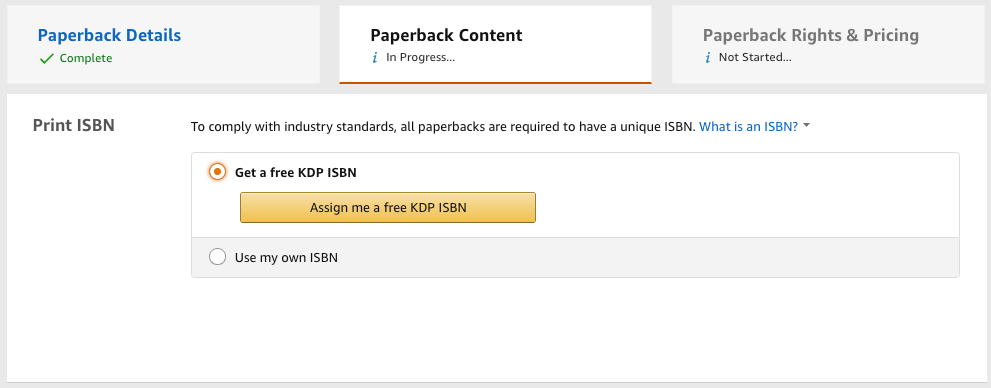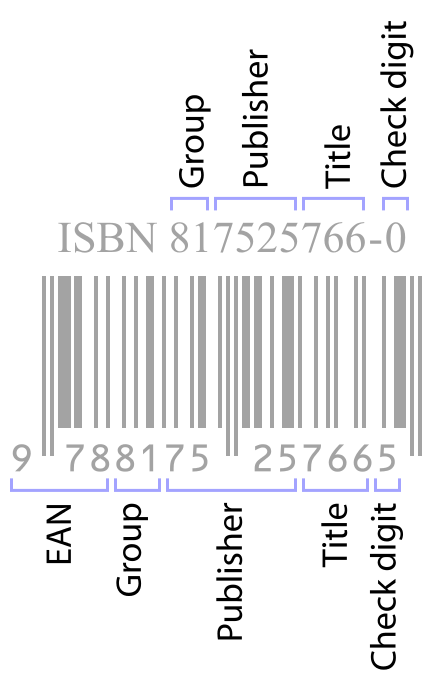Beginner’s Guide to ISBNs
You’re merrily chugging along, uploading your book into KDP Print, and then you see this screen:

“Whoa,” you say. “This is getting real.” ISBNs are on real books for real authors, and here you are not deciding whether or not you want one, but what kind you’re going to get.
A lot of authors just go with the free Amazon ISBN because it’s easiest. For a lot of those authors, it’s a decision that doesn’t leave enough money on the table for them to be wrong. But your best bet is to understand ISBNs as completely as possible, so you can make an informed decision about what your writing and career need.
But First, This…
If you plan to publish e-book only, or you don’t plan to make print copies for a year or more from now, go ahead and skip this article. Only print books need an ISBN. Go focus on making your e-book empire shine like the sun, and come back to this when you think it’s time to expand into print.
Okay, Then. What’s an ISBN?
ISBN stands for International Standard Book Number. It’s like a social security number for your book, and helps bookstores and libraries manage inventory and track sales trends.
If you live anywhere but the US or the UK, you’re in luck. ISBNs are handled by the government and given out for free. Find out about your particular country’s guidelines and process here.
In the US and the UK, they are organized by for-profit groups: Bowker in the US, and Nielsen in the UK. They charge publishers, including self-publishers, for ISBNs. More on that in a bit.
An ISBN is now a 13-digit number (previously it was only 10 digits until 2007), consisting of five parts:

- (First 3 digits) – An identifier code saying this is a book (and not the code for a toothbrush or can of Spaghetti-Os). This will be 978 or 979.
- (Next digit) – A one-digit code indicating country and language group. “1” means English speaking and in the Australia, Canada, New Zealand, United Kingdom or United States. South Africa and Belize, despite being English-speaking nations, have a different code.
- (Next digit grouping) – Identifier code for the publisher, including showing how many ISBNs that publisher purchased with this ISBN. Five digits means this group has 1,000 ISBNs, six digits means there are 100, and seven digits means there are 10 ISBNs.
- (Next digits) – Identifier code for the book itself: title, edition, and format. The paperback and hardback of the same book have different ISBNs, for example.
- (Final 1 digit) – A “check digit” that’s part of how the computers interact with the code. In part this tells a scanner it’s reached the end of the number sequence, and it's mathematically calculated based on the rest of the digits in the ISBN to verify that none of the numbers were mistyped or transposed.
You find an ISBN as part of the publisher bar code printed on the back cover of most books. In some cases, a bookseller will paste a different bar code sticker on top of it, because they can’t work and play well with others. You never have to worry about this. It’s beyond your control and has absolutely zero impact on your sales.
Why Do I Want an ISBN?
Although not every bookstore, library, university, or other bookseller requires an ISBN, all book buyers have the option of doing so. The concept and standard streamlines purchasing and inventory management so well that many booksellers won’t buy your book without one.
A book with an ISBN has more opportunities to sell than a book without one. Whether or not you’ll actually be in a position to leverage those opportunities is another matter. More on that in a bit.
All ISBNs Are Not Created Equal
If you’re publishing via KDP, you have two options for ISBN:
- A free KDP ISBN, which costs you nothing but sets Amazon as the publisher of record. It works internally for Amazon and allows you to print on demand with KDP Print, but you can't print your book anywhere else (like Ingram Spark.) It'll make it more difficult to get your book sold anywhere other than Amazon, even if you use their “expanded distribution” option.
- A “normal” ISBN, which costs money and is part of the international system described above.
If you do even a brief search for other ISBN information, you’ll see two other options: Custom ISBN and Custom Universal ISBN. Those were offerings from CreateSpace, which Amazon folded into KDP in 2018. That simplifies your choices considerably.
So, What Do I Do?
The decision here is about price vs. functionality. If you plan to sell your print books only on Amazon and at events where you bring books yourself, there’s nothing wrong with an Amazon ISBN. It’s free, and the process is simpler than providing your own.
However, you should get your own ISBN if any of the following are important to you:
- Getting orders for your books direct from bookstores.
- Selling your books on other online marketplaces.
- Entry into some contests, and for some rewards.
- Eligibility for many grants.
- Making a run for a New York Times, USA Today, or other bestseller list.
One way to look at it is how professional do you see your career as a writer being for the next three to five years. If it’s a part-time gig or hobby, then you won’t have need of the extra benefits inherent with having your own ISBN. They aren’t likely to earn out the cost of buying the ISBN. Besides, many people with full-time regular jobs lack the time to leverage the tools an ISBN brings.
By contrast, if you’re “going big” with the time and intention to sell your books everywhere you can, an ISBN is worth the investment. Speaking of investments, check the table below for the prices you can expect to pay for your own ISBN.
| Bowker | L&A Canada | Nielsen | |
| 1 ISBN | $125 ($125 each) | Free | £93 (£93 each) |
| 10 ISBNs | $295 ($29.50 each) | Free | £174 (£17.40 each) |
| 100 ISBNs | $575 ($5.75 each) | Free | £387 (£3.87 each) |
| 1,000 ISBNs | $1,500 ($1.50 each) | Free | £994 (£0.99 each) |
It’s pretty clear that the number of ISBNs you should buy is the largest package you can afford. You do not have to assign each ISBN immediately. Rather, you’re holding the numbers for whenever you need them. The pricing is simply too optimized for bulk to choose any other option.
Final Note: Changing ISBNs
One last important thing to know. Each new edition and format of your book needs its own unique ISBN.
That means a different trim size, printing with a different binding, translations to a new language, new editions, printings with significant changes to the content, and new titles all require their own ISBNs. See also audiobook editions, omnibus, bundles, and packages.
On the other hand, minor changes including a new cover, small corrections to the content, new prices, and a new printing company for what is otherwise the same book do not require a new ISBN. You can continue to use the original.
Got more questions or want more details about ISBNs, how they work, and when you would (or wouldn't) want to use them? Check out Apex Authors Training #100 – All About ISBNs for a full training session that should answer all of your questions!
Last Updated: August 4, 2025

